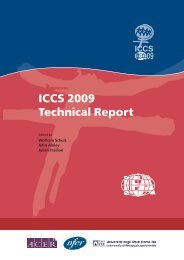Teacher Education and Development Study in Mathematics - IEA
Teacher Education and Development Study in Mathematics - IEA
Teacher Education and Development Study in Mathematics - IEA
You also want an ePaper? Increase the reach of your titles
YUMPU automatically turns print PDFs into web optimized ePapers that Google loves.
PART 1: TEACHER RELATIVE PAY AND STUDENT PERFORMANCE<br />
47<br />
Whatever the explanation, higher relative teacher salaries are associated with higher test<br />
scores, even when we control for other important factors associated with those higher<br />
test scores. Because our sample of countries was small, more work is needed to test<br />
whether this is a policy variable or just an <strong>in</strong>dicator of someth<strong>in</strong>g else that expla<strong>in</strong>s high<br />
test scores <strong>and</strong> that correlates with the ratio of teacher salaries relative to the salaries of<br />
other professions.<br />
An additional caveat is that rais<strong>in</strong>g teacher salaries across the board (for all teachers<br />
<strong>in</strong> the teacher labor force) <strong>in</strong> those countries with relatively low teacher salaries is an<br />
expensive policy option. A much cheaper option is to raise the salaries only of start<strong>in</strong>g<br />
teachers or only of teachers with skills <strong>in</strong> short supply, such as mathematics <strong>and</strong> science.<br />
However, these alternatives may face opposition from teachers’ unions. And, as we have<br />
mentioned, any salary-<strong>in</strong>crease policy <strong>in</strong>volves many unknowns, such as the response<br />
rate of higher ability <strong>in</strong>dividuals to higher salaries <strong>in</strong> teach<strong>in</strong>g. A number of analysts<br />
have argued that more spend<strong>in</strong>g per student on education does not produce higher<br />
student test scores (see, for example, Hanushek et al., 1994). Although the empirical<br />
foundations of this argument are highly problematic (see, for example, Rothste<strong>in</strong> &<br />
Miles, 1995), there is enough of a case aga<strong>in</strong>st simply rais<strong>in</strong>g teacher salaries as a policy<br />
tool <strong>in</strong> order to improve school<strong>in</strong>g outcomes to create considerable political resistance<br />
to it.<br />
Nevertheless, the underly<strong>in</strong>g notion that societies that seriously want to improve their<br />
students’ performance <strong>in</strong> school must improve the quality of teachers <strong>in</strong> schools is also<br />
compell<strong>in</strong>g. It is difficult to determ<strong>in</strong>e how that improvement could be made other than<br />
to raise the bar that <strong>in</strong>dicates the level of skills <strong>in</strong>dividuals must have to enter teach<strong>in</strong>g.<br />
But if the bar is raised, it is also difficult to conceive of a means of attract<strong>in</strong>g <strong>in</strong>dividuals<br />
<strong>in</strong>to teach<strong>in</strong>g with those high skills other than that of mak<strong>in</strong>g teacher remuneration<br />
competitive with the remuneration offered <strong>in</strong> other professions requir<strong>in</strong>g a similar level<br />
of academic skills.<br />
References<br />
Allegretto, S. A., Corcoran, S. P., & Mishel, L. (2004). How does teacher pay compare? Methodological<br />
challenges <strong>and</strong> answers. Wash<strong>in</strong>gton, DC: Economic Policy Institute.<br />
Carnoy, M., Gove, A., & Marshall, J. (2007). Cuba’s academic advantage. Palo Alto, CA: Stanford<br />
University Press.<br />
Carnoy, M., Marshall, J., & Socias, M. (2003). How do school <strong>in</strong>puts <strong>in</strong>fluence math scores? A<br />
comparative approach. St<strong>and</strong>ford, CA: Stanford School of <strong>Education</strong> (mimeo).<br />
Chiu, M. M., & <strong>and</strong> Khoo, L. (2005). Effects of resources, <strong>in</strong>equality, <strong>and</strong> privilege bias on<br />
achievement: Country, school, <strong>and</strong> student level analyses. American <strong>Education</strong>al Research Journal,<br />
42(4), 575–603.<br />
Clotfelter, C., Ladd, H., & Vigdor, J. (2007). How <strong>and</strong> why do teachers matter for student achievement?<br />
(Work<strong>in</strong>g paper 12828). Cambridge, MA: National Bureau of Economic Research.<br />
Corcoran, S., Evans, W. N., & Schwab, R. S. (2002). Chang<strong>in</strong>g labor market opportunities for women<br />
<strong>and</strong> the quality of teachers, 1957–1992 (National Bureau of Economic Research Work<strong>in</strong>g Paper<br />
9180). Available onl<strong>in</strong>e at http://www.nber.org/papers/w9180.<br />
De<strong>in</strong><strong>in</strong>ger, K., & Squire, L. (1996). A new data set measur<strong>in</strong>g <strong>in</strong>come <strong>in</strong>equality. World Bank<br />
Economic Review, 10(3), 565–591.<br />
Ehrenberg, R., & Brewer, D. (1995). Did teachers’ verbal ability <strong>and</strong> race matter <strong>in</strong> the 1960s?<br />
Coleman revisited. Economics of <strong>Education</strong> Review, 14(1), 1–21.

















